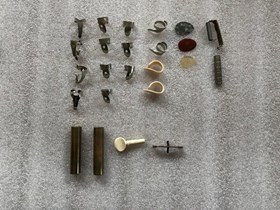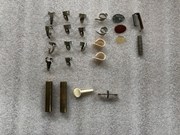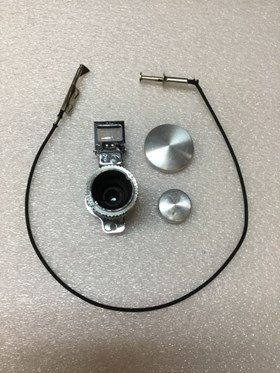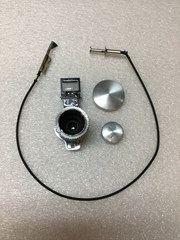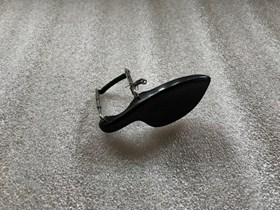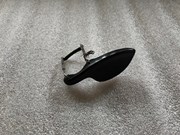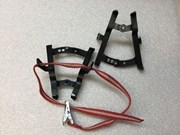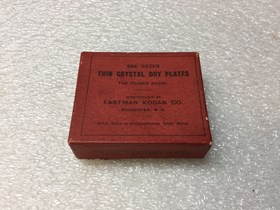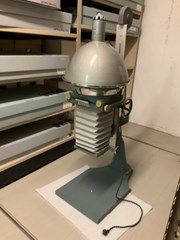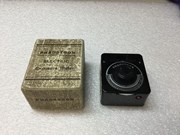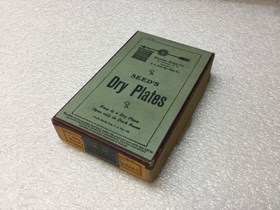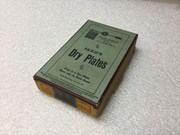Narrow Results By
Accessories Guitar Accessories
https://archives.whyte.org/en/permalink/artifact104.34.0008%20a-m
- Date
- 1930 – 1950
- Material
- metal; wood; ivory; plastic
- Catalogue Number
- 104.34.0008 a-m
- Description
- A collection of odd guitar accessories. (a) finger pick set (3.4 x 2.0 diam) four metal frames that fit over the finger tip,Y-shaped with the arms of the Y forming an adjustable band that fits around finger, and the stem of the Y passing up over the tip of the finger and down the back halfway to t…
1 image
- Title
- Accessories Guitar Accessories
- Date
- 1930 – 1950
- Material
- metal; wood; ivory; plastic
- Dimensions
- 3.4 cm
- Description
- A collection of odd guitar accessories. (a) finger pick set (3.4 x 2.0 diam) four metal frames that fit over the finger tip,Y-shaped with the arms of the Y forming an adjustable band that fits around finger, and the stem of the Y passing up over the tip of the finger and down the back halfway to the band, tip is crimped in stiff fold, 3 have solder at the tip to form a longer point. (MFG: Fitrite).(b) finger pick set (2.5 x 1.8 x 2.0) six metal rings that fit over the finger tips, adjustable band has circles cut out along it, flame shaped fingernail rises from band, curling inward slightly, and with cut out circle at middle. (mfg: National) (c) finger pick (2.5 x 1.9 x 2.0) as (b) but without cut out circles (mfg: Artisto) (d) finger picks (3.0 x 1.7 x 1.9) two metal bands that wrap around finger tip, widening near the end, then narrowing to a point that extends off to one side of the finger. (e) finger picks (3.5 x 1.5 x 1.9) two flat ivory bands which curl once around finger tip and extend out to one side in a point. (f) pick (3.2 x 2.3 x .1) small, flat, egg shaped, marbleized, grey plastic, stiff. (mfg: Durro). (g) pick (3.0 x 2.2 x .1) as (f) but brown tortoise shell coloured plastic (mfg: Eureka). (h) pick (2.7 x 1.9 x .1) as (f) but transparent yellowed plastic ?, slightly curled. (i) capo (5.3 x 1.9 x .9) flat metal bar with small hooks at either end to hold tightly coiled spring across the under side, lined underneath bar with cork. (mfg: Elton). j) bridge ? (4.7 x .8 x 1.1) a long, half round, hollow metal bar with six incised rings spaced evenly along the length. (mfg: Kamiki). (k) slides (7.2 x 1.7 diam) two heavy, solid, brass rods (used to slide over strings when playing the guitar Hawaiian style) (1) peg (5.0 x .9 x 2.3) white, cast plastic peg with long shaft and flattened key with finger depression each side, ferrules around top of shaft. (m) bridge (4.7 x 1.4 x 1.9) low, unfinished wood bridge with small dark support perpendicularly across under middle, short legs thicken slightly at base, series of small notches across top, some deliberately cut into wood, some worn in odd places from strings (mfg: Grover).
- Subject
- Whyte home
- households
- entertainment
- pastime
- Annie White
- music
- accessories
- equipment
- sound
- song
- Credit
- Gift of Catharine Robb Whyte, O. C., Banff, 1979
- Catalogue Number
- 104.34.0008 a-m
Images
This material is presented as originally created; it may contain outdated cultural descriptions and
potentially offensive content.
Read more.
Camera Accessories
https://archives.whyte.org/en/permalink/artifact104.41.0185%20a%2cb
- Date
- 1923 – 1940
- Material
- metal; glass; fabric;
- Catalogue Number
- 104.41.0185 a,b
- Description
- Silver metal Kodak lens with mounting plate that includes a fold-up view finder [possibly for a Ciné-Kodak motion picture camera] with black velvet-lined lens caps and a black fabric-wrapped extension trigger for an unknown camera.
1 image
- Title
- Camera Accessories
- Date
- 1923 – 1940
- Material
- metal; glass; fabric;
- Dimensions
- 4.2 x 4.1 x 9.6 cm
- Description
- Silver metal Kodak lens with mounting plate that includes a fold-up view finder [possibly for a Ciné-Kodak motion picture camera] with black velvet-lined lens caps and a black fabric-wrapped extension trigger for an unknown camera.
- Credit
- Gift of Robert Crosby Family, Banff, 1998
- Catalogue Number
- 104.41.0185 a,b
Images
This material is presented as originally created; it may contain outdated cultural descriptions and
potentially offensive content.
Read more.
- Date
- 1950 – 1970
- Material
- leather; metal; glass; plastic; fabric; wood
- Catalogue Number
- 104.41.0107 a,b
- Description
- Manufacturer details for Enlarger housed within box.Black equipment box with a hinged lid held closed with leather tabs/snaps as well as an olive green fabric strap wrapped around the box. The interior of the box is lined with blue velvet and has both plain wood and covered supports and braces thro…
1 image
- Title
- Camera Box
- Date
- 1950 – 1970
- Material
- leather; metal; glass; plastic; fabric; wood
- Dimensions
- 24.9 x 22.5 x 42.7 cm
- Description
- Manufacturer details for Enlarger housed within box.Black equipment box with a hinged lid held closed with leather tabs/snaps as well as an olive green fabric strap wrapped around the box. The interior of the box is lined with blue velvet and has both plain wood and covered supports and braces throughout. Contents of the box consists only of a Kodak Precision Enlarger with the open metal end capped with a cardboard box.
- Credit
- Gift of Nicholas Morant, Banff, 2006
- Catalogue Number
- 104.41.0107 a,b
Images
This material is presented as originally created; it may contain outdated cultural descriptions and
potentially offensive content.
Read more.
- Date
- 1950 – 1980
- Material
- leather; fabric; plastic; metal;
- Catalogue Number
- 104.41.0137
- Description
- A grey plastic handheld flash with an expandable reflective disk in a black leather box lined with dark red velvet.The flash has a hook on the bottom where it can be fitted onto a camera, an articulated head where the reflective disk is, a distance gauge on the back [it was taped into a particular …
1 image
- Title
- Camera Flash
- Date
- 1950 – 1980
- Material
- leather; fabric; plastic; metal;
- Dimensions
- 4.2 x 5.5 x 12.0 cm
- Description
- A grey plastic handheld flash with an expandable reflective disk in a black leather box lined with dark red velvet.The flash has a hook on the bottom where it can be fitted onto a camera, an articulated head where the reflective disk is, a distance gauge on the back [it was taped into a particular position with a piece of clear tape that has since come unstuck], and a green plastic cord coming out of the front of the flash just below the disk.The box has a leather hinged lid and is held closed with a snap on a leather tab.
- Credit
- Gift of Nicholas Morant, Banff, 2006
- Catalogue Number
- 104.41.0137
Images
This material is presented as originally created; it may contain outdated cultural descriptions and
potentially offensive content.
Read more.
Chin Rest Violin Accessories
https://archives.whyte.org/en/permalink/artifact104.34.0006
- Date
- 1950 – 1960
- Material
- wood; metal; wood; fibre
- Catalogue Number
- 104.34.0006
- Description
- A black, spoon shaped chin rest with metal brackets. Carved wood with very gentle depression to cup chin, and short, curved arm to one side. Small, flat pieces of cork glued underneath at points that will rest on violin. U-shaped bracket of steel which adjusts by turnbuckles, hanging down from sid…
1 image
- Title
- Chin Rest Violin Accessories
- Date
- 1950 – 1960
- Material
- wood; metal; wood; fibre
- Dimensions
- 5.5 x 4.4 x 10.7 cm
- Description
- A black, spoon shaped chin rest with metal brackets. Carved wood with very gentle depression to cup chin, and short, curved arm to one side. Small, flat pieces of cork glued underneath at points that will rest on violin. U-shaped bracket of steel which adjusts by turnbuckles, hanging down from side of chin rest, clamps to edge of violin. Bottom bar lined fastened to bracket by twisted multi strand wire. Marks: stamped into metal under bar of bracket, "made in Germany" Note: felt loose.
- Credit
- Gift of Catharine Robb Whyte, O. C., Banff, 1979
- Catalogue Number
- 104.34.0006
Images
This material is presented as originally created; it may contain outdated cultural descriptions and
potentially offensive content.
Read more.
- Date
- 1960 – 2000
- Material
- metal; fabric;
- Catalogue Number
- 108.04.0047
- Description
- Pair of black metal crampons, only one has a red and white fabric strap to go over the foot with a silver metal cinch. The crampons consist of two pieces of metal that fit together in a way that lets them expand or contract at one end, depending on the user’s foot size. Each crampon has four spikes…
1 image
- Title
- Crampons
- Date
- 1960 – 2000
- Material
- metal; fabric;
- Dimensions
- 5.5 x 10.3 x 11.3 cm
- Description
- Pair of black metal crampons, only one has a red and white fabric strap to go over the foot with a silver metal cinch. The crampons consist of two pieces of metal that fit together in a way that lets them expand or contract at one end, depending on the user’s foot size. Each crampon has four spikes and two upward extensions through which the strap can be fed.
- Subject
- Eddie Hunter
- hiking
- winter
- outdoor equipment
- Credit
- Gift of Eddie Hunter, Banff, 1995
- Catalogue Number
- 108.04.0047
Images
This material is presented as originally created; it may contain outdated cultural descriptions and
potentially offensive content.
Read more.
- Date
- 1920 – 1940
- Material
- cardboard; paper; glass;
- Catalogue Number
- 104.41.0220
- Description
- Box of one dozen Thin Crystal Dry Plates for a Pocket Kodak camera. The box’s seal has been broken - inside are alternating layers of thin black paper and the glass plates, which are fogged.Dry plate, or the gelatin process, was invented by Dr. Richard L. Maddox in 1871 and replaced the more time-c…
1 image
- Title
- Dry Plates
- Date
- 1920 – 1940
- Material
- cardboard; paper; glass;
- Dimensions
- 1.9 x 6.0 x 5.1 cm
- Description
- Box of one dozen Thin Crystal Dry Plates for a Pocket Kodak camera. The box’s seal has been broken - inside are alternating layers of thin black paper and the glass plates, which are fogged.Dry plate, or the gelatin process, was invented by Dr. Richard L. Maddox in 1871 and replaced the more time-consuming wet plate, or collodion process, which required active wet chemicals to be prepared in mobile dark rooms. The dry plate process underwent several adaptations throughout the 1870s and, in 1879, George Eastman developed a method of applying the emulsion layer to glass in a factory setting, simultaneously creating what came to be known as the Eastman Kodak Co. and bringing down the cost of photography so as to be accessible to the masses.
- Subject
- photography
- photographic equipment
- Credit
- Gift of Catharine Robb Whyte, O. C., Banff, 1979
- Catalogue Number
- 104.41.0220
Images
This material is presented as originally created; it may contain outdated cultural descriptions and
potentially offensive content.
Read more.
- Date
- 1950 – 1965
- Material
- metal; plastic; fabric;
- Catalogue Number
- 104.41.0162
- Description
- Large photographic negative enlarger. Mostly made of blue-grey metal, the enlarger consists of a large rectangular base with a support arm rising from the back which holds the enlarging mechanism. Hand-crank wheels on either side of the support arm allows the enlarger to be moved up and down. The t…
1 image
- Title
- Englarger
- Date
- 1950 – 1965
- Material
- metal; plastic; fabric;
- Dimensions
- 140.0 x 40.0 x 74.0 cm
- Description
- Large photographic negative enlarger. Mostly made of blue-grey metal, the enlarger consists of a large rectangular base with a support arm rising from the back which holds the enlarging mechanism. Hand-crank wheels on either side of the support arm allows the enlarger to be moved up and down. The top of the enlarger is a large silver dome [possibly the light] with the black and white fabric-wrapped power cord coming out the top, the dome sits on top of the main blue-grey metal tray where more dials can adjust settings and the tray for inserting the original negative sides out the front, coming out the bottom of the frame is a grey bellows that has the focussing lens on the bottom.
- Subject
- Nicholas Morant
- photography
- photograph equipment
- darkroom
- camera equipment
- photograph developing
- Credit
- Gift of Nicholas Morant, Banff, 2006
- Catalogue Number
- 104.41.0162
Images
This material is presented as originally created; it may contain outdated cultural descriptions and
potentially offensive content.
Read more.
Exposure Meter
https://archives.whyte.org/en/permalink/artifact104.41.0195
- Date
- 1940 – 1941
- Material
- plastic; metal; cardboard;
- Catalogue Number
- 104.41.0195
- Description
- Black plastic hand-held exposure meter with a metal and plastic dial with a raised knob on the front below a depressed window where the exposure meter is. On the bottom of the meter just below the main dial is the exposed lip of the metal dial so that it can be rotated and a small round red plastic…
1 image
- Title
- Exposure Meter
- Date
- 1940 – 1941
- Material
- plastic; metal; cardboard;
- Dimensions
- 5.2 x 7.2 x 9.2 cm
- Description
- Black plastic hand-held exposure meter with a metal and plastic dial with a raised knob on the front below a depressed window where the exposure meter is. On the bottom of the meter just below the main dial is the exposed lip of the metal dial so that it can be rotated and a small round red plastic button. On the back of the meter is a metal screw in the middle [possibly to allow access to the interior], manufacturer details, and a thin strip of fabric adhesive with F.L. Crosby’s address details typed on it in black. The cardboard box has a patterned brown and white lid that fits completely over a beige body and is lined with packing cardboard.
- Credit
- Gift of Robert Crosby Family, Banff, 1998
- Catalogue Number
- 104.41.0195
Images
This material is presented as originally created; it may contain outdated cultural descriptions and
potentially offensive content.
Read more.
Exposure Plates
https://archives.whyte.org/en/permalink/artifact104.41.0207
- Date
- 1902 – 1920
- Material
- cardboard; paper; glass;
- Catalogue Number
- 104.41.0207
- Description
- Box of one dozen 3 1/4 x 5 1/2 glass Seed’s Dry Plates with cut paper adhesive tape around the edges and bottom and manufacturer details printed on a pale green background throughout the lid. These dry plates were invented by M.A. Seed in 1879 and became very popular with photographers as the plate…
1 image
- Title
- Exposure Plates
- Date
- 1902 – 1920
- Material
- cardboard; paper; glass;
- Dimensions
- 3.0 x 9.3 x 15.0 cm
- Description
- Box of one dozen 3 1/4 x 5 1/2 glass Seed’s Dry Plates with cut paper adhesive tape around the edges and bottom and manufacturer details printed on a pale green background throughout the lid. These dry plates were invented by M.A. Seed in 1879 and became very popular with photographers as the plates came pre-prepared with the emulsion layer already applied - prior to “dry” plates, photographers would need portable dark rooms in which they would create their liquid emulsions prior to taking a photograph [known as “wet” plates]. Seed’s dry plates still required they be opened in a dark room, but this could be accomplished in the field by placing a dark sheet over the camera while loading and unloading the plates. In 1902, Eastman Kodak purchased Seed’s company [Seed Dry Plate Co.], but continued to capitalize on his name due to its reputation among consumers.
- Credit
- Gift of Robert Crosby Family, Banff, 1998
- Catalogue Number
- 104.41.0207
Images
This material is presented as originally created; it may contain outdated cultural descriptions and
potentially offensive content.
Read more.

